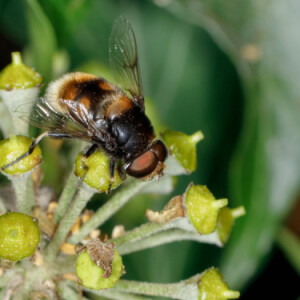Puzzling
This is only the second Eristalis intricaria I've photographed this year, and the first I've seen in the village for five years. It's a widely distributed species, but according to the Hoverfly Recording Scheme it's especially abundant in northern and upland environments, and most frequently found in damper locations. Numbers fluctuate a lot from year to year, depending on the weather.
Adults fly from March to November, and are usually found visiting flowers, especially white umbels, ragwort and thistles, or flowering shrubs. In the spring it's worth looking for hovering males around flowering trees such as blackthorn and willows. The larvae, which are among the group known as rat-tailed maggots, occur in wet organic matter such as mud, waterlogged peat, slurry pits and cow-dung, breathing air from the surface via long tubes.
The nearest I can get to a translation of 'intricaria' is puzzling or confusing. I don't know why this hoverfly was given this name, but it is fairly easily confused with a number of other furry bumblebee mimics such as Merodon equestris, Volucella bombylans, and Criorhina ranunculi. (I posted a photo of one I found at Trench Wood a couple of weeks ago to my Facebook page, and promptly had the identification queried by a page follower.) I've added the next shot in my sequence as an extra today, because it shows the typical Eristalis abdominal markings of this male underneath his fur. These patterns are diagnostic when you can see them, as are the feathery (plumose) aristae on the antennae, and the yellow scutellum. Interestingly, this male has quite a pale tail, whereas typically you'd expect it to be orange. The tails of female Eristalis intricaria are always white.


Comments
Sign in or get an account to comment.


